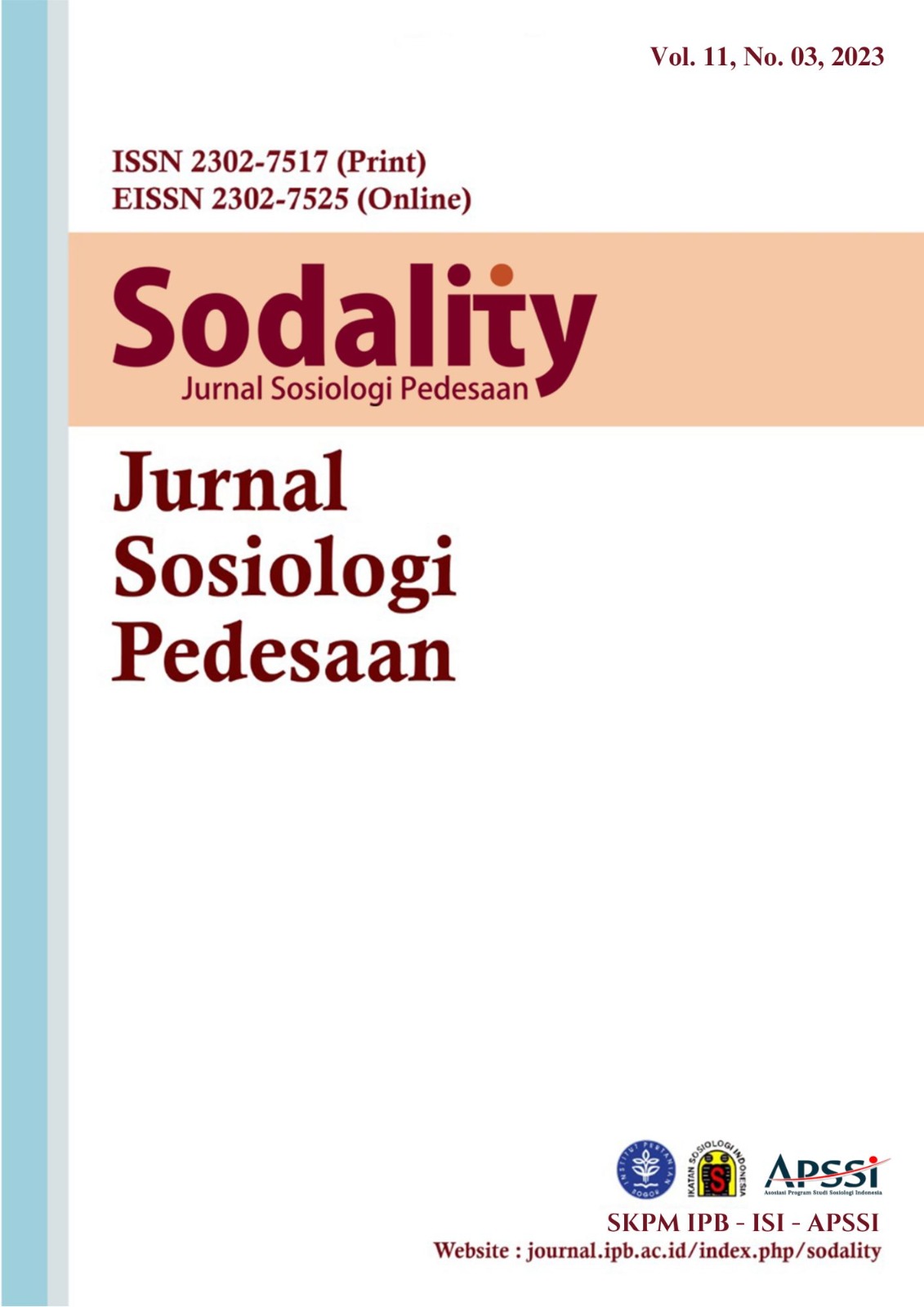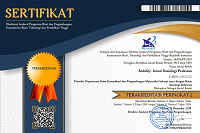The Cosmology of Menoreh Customary Tradition in Indigenous People Perspective
Abstract
The concept of indigenous peoples is a global concern in local development including by international institutions such as the International Labour Organization. One indicator of indigenous peoples is cosmological knowledge which often incorporates deep connections between the material, spiritual realms and emphasizes the connective interconnectedness between humans and nature. Its development later became an international convention to protect the existence of indigenous peoples. This research uses ethnographic methods to explore the cosmology and memorial story of Menoreh indigenous people who do not recognize the administrative boundaries of the district so that they can perform traditional ceremonies from an indigenous perspective. Menoreh’s landscape illustrates the cosmological relationship between the local market, the Baritan ceremony, and the conservation of spring sacralization, which is a sustainable customary praxis. The ritual element of the cosmological axis of social interaction leads to two concepts. First, the relationship between Menoreh (caretakers as indigenous actors) and pilgrims' actions as visitors becomes an elementary social interaction. Second, the tradition of offerings and memorial of spirits (petilasan) becomes an elementary symbolic form.
References
Aliansi Masyarakat Adat Nusantara [AMAN]. (2022). Catatan Tahun 2022- NGO-AMAN.
Asmuni, A. (2021). Moral Teachings and Spirituality in Manuscript Studies: A Critical Study of Social Values in the Digital Age. Journal of Social Studies Education Research, 12(4), 302–319. https://doi.org/https://www.learntechlib.org/p/220462/
Barth, F. (1987). Cosmologies in the Making: A Generative Approach to Cultural Variation in Inner New Guinea. Cambridge University Press.
Beck, H. L. (2018). Back to Sendangsono: A Marian Pilgrimage Site as a Lens on Central Javanese Cultural Values. Bijdragen tot de taal-,. Land-En Volkenkunde/Journal of the Humanities and Social Sciences of Southeast Asia, 174(2-3), 244–263. https://doi.org/https://doi.org/10.1163/22134379-17401023
Carey, P. (2008). Prince Dipanegara and The End of An Old Older in Java 1785-1855. KITLV Press.
Chittick, W. C. (2014). Science of the Cosmos, Science of the Soul. The Pertinence of Islamic Cosmology in the Modern World. Simon & Schuster Press.
Cresswell, J. (2014). Research Design. Sage Publications.
Danandjaja, J. (1991). Folklor Indonesia. Grafiti Pers.
Diaw, M. Aseh, T. and R. P. (2009). In Search of Common Ground: Adaptive Collaborative Management in Cameroon. Cifor.
Dodelson, S, & Schmidt, F. (2020). Modern Cosmology. Academic press.
Duck, W. and K. (2019). Interaction Order as Cultural Sociology within Urban Ethnography. Urban Ethnography, vol.16((Research in Urban Sociology, Vol. 16), Emerald Publishing Limited), 113–130. https://doi.org/https://doi.org/10.1108/S1047-004220190000016009.
Dundes, A. (1962). From etic to emic units in the structural study of folktales. The Journal of American Folklore, 95–105. https://doi.org/https://doi.org/10.2307/538171
Garfinkel, H. (1967). Studies in Ethnomethodology. Prentice-Hall.
Goffman, E. (1967). Interaction ritual: Essays in face-to-face behavior. Anchor Books.
Goffman, E. (2017). Interaction Ritual: Essays in Face-to-Face Behavior. 1–270. https://doi.org/https://doi.org/https://doi.org/10.4324/9780203788387
Gullion, J. S. (2021). Writing ethnography. E.J. Brill.
Heikkilä, E. (2020). The Ethnographer as a Storyteller. Memoriamedia.
Holt, C. (1967). Art in Indonesia: Continuities and Change. Cornell University Press.
International Labor Organization [ILO]. (1989). Laporan Konvensi ILO: Sebuah Panduan dari Jenewa.
Kamil, A.D. Ilham, I. Ikramatoun, S. Meliza, R. S. (2021). Bur Telege: Etnografi Gerakan Kolektif Masyarakat Dalam Membangun Wisata Halal. Aceh Anthropological Journal, 5(2), 118–137. https://doi.org/https://doi.org/10.3390/su14159632
Karjanto, N. (2020). Revisiting Indigenous Wisdom of Javanese Pranata mangsa. Comment on Zaki et al. Adaptation to Extreme Hydrological Events by Javanese Society through Local Knowledge. Sustainability, 14(15)(96:32). https://doi.org/https://doi.org/10.3390/su14159632
Kathirithamby-Wells, J. (1993). Hulu-hilir Unity and Conflict: Malay Statecraft in East Sumatra before the Mid-Nineteenth Century. Archipel Journal, (45)(1993), 77–96. https://doi.org/Doi : https://doi.org/10.3406/arch.1993.2894.
Khairunnisa, M. (2014). Kosmologi Ruang Adat Sebagai Identitas Pemukiman Kampung Nga, Tasikmalaya-Jawa Barat. Jurnal Teknik Universitas Diponegoro, 35(1)(2014), 49–55. https://doi.org/https://ejournal.undip.ac.id/index.php/teknik.
Lombard, D. (2018). Nusa Jawa Silang Budaya 1: Batas-Batas Pembaratan (5th edition). Gramedia.
Marvasti, A. (2004). Qualitative Research in Sociology. Sage Publication.
Matics, K. I. (1998). Gestures of the Buddha. Chulalongkorn University Press.
Nagaoka, M. (2016). Cultural Landscape Management at Borobudur, Indonesia. Springer International Publishing.
Permono, A. (2021). Sangkan Paraning Dumadi Sumbu Filosofi Yogyakarta: Dalam Lensa Fenomenologi-Hermeneutika. Nun: Jurnal Studi Al-Quran Dan Tafsir Di Nusantara, 7(1), 163–208. https://doi.org/https://doi.org/10.32495/nun.v7i1.233
Roth, D & Sedana, G. (2015). Reframing Tri Hita Karana: From ‘Balinese Culture’to Politics. The Asia Pacific Journal of Anthropology, 16 (2), 157–175. https://doi.org/10.1080/14442213.2014.994674
Sahlins, M. (2013). Culture and Practical Reason. The University of Chicago Press.
Sekar, A. Y. (2021). Analisis Kosmologi Pola Tiga dalam Tradisi Nyeupah pada Masyarakat Sunda. Gelar : Jurnal Seni Budaya, 19(1), 60–66. https://doi.org/10.33153/glr.v19i1.3509
Spradley, J. (1987). Participant Observation. Harcourth College Publisher.
Wasitaatmadja, D. F. F. (2020). Etnografi hukum Budaya Hukum Masyarakat Cina Jelata. prenadamedia group.
Wattimena, L. (2017). Cosmology of Habo Tetear Kei People , Southeast Molluccas. Purbawidya, 6(1), 33–42. https://doi.org/https://doi.org/10.24164/pw.v6i1.151
Copyright (c) 2024 Ahmad Arrozy, Masdar Faridl, Febri Edytya Salsabila, Zahra Nada Novalina, Siti Muhibah, Rizqina Mukarromah

This work is licensed under a Creative Commons Attribution-ShareAlike 4.0 International License.
Authors who publish with this journal agree to the following terms:
- Authors retain copyright and grant the journal right of first publication with the work simultaneously licensed under a

This work is licensed under a Creative Commons Attribution 4.0 International License. that allows others to share the work with an acknowledgement of the work's authorship and initial publication in this journal. - Authors are able to enter into separate, additional contractual arrangements for the non-exclusive distribution of the journal's published version of the work (e.g., post it to an institutional repository or publish it in a book), with an acknowledgement of its initial publication in this journal.
- Authors are permitted and encouraged to post their work online (e.g., in institutional repositories or on their website) prior to and during the submission process, as it can lead to productive exchanges, as well as earlier and greater citation of published work (See The Effect of Open Access).





.png)










